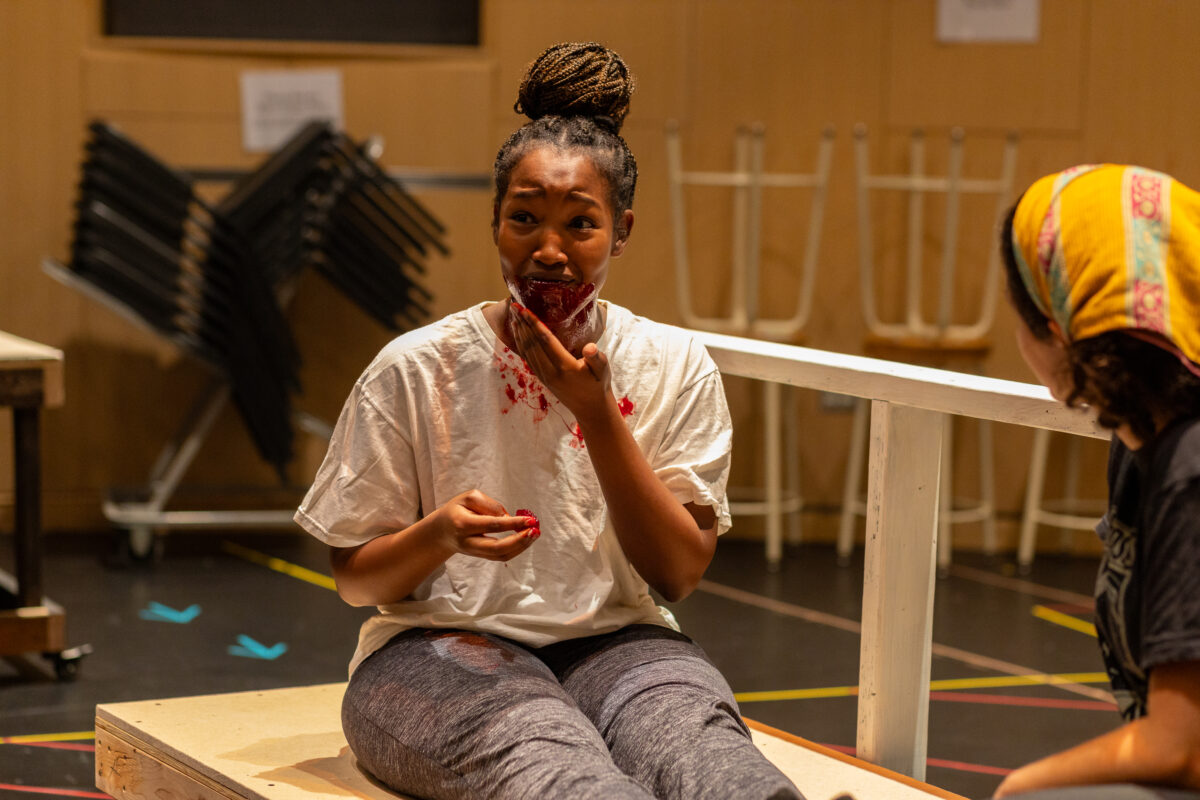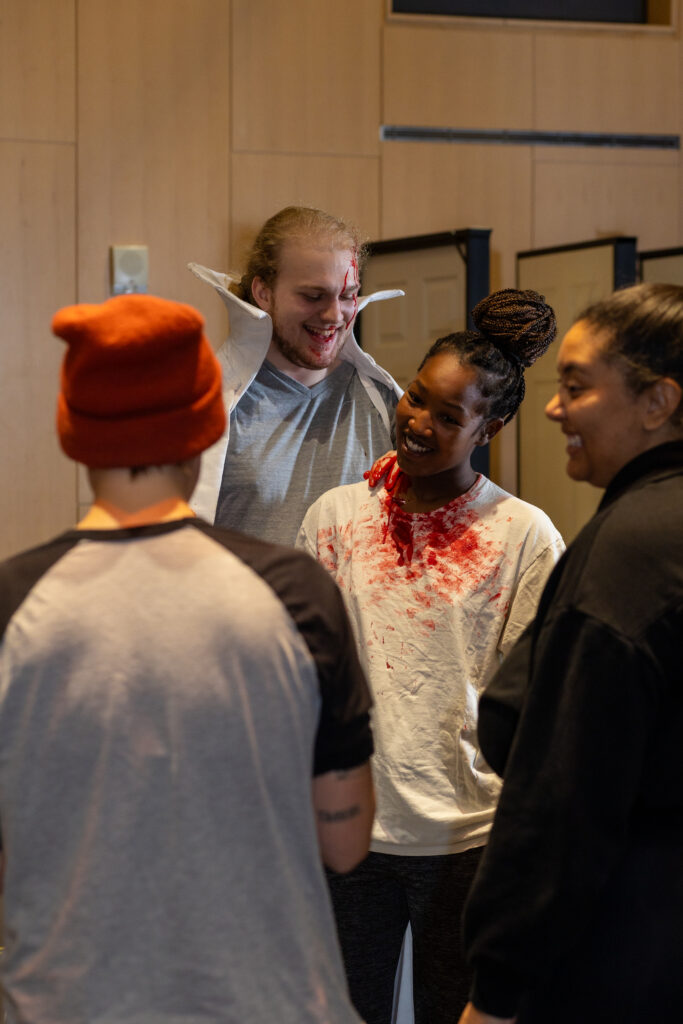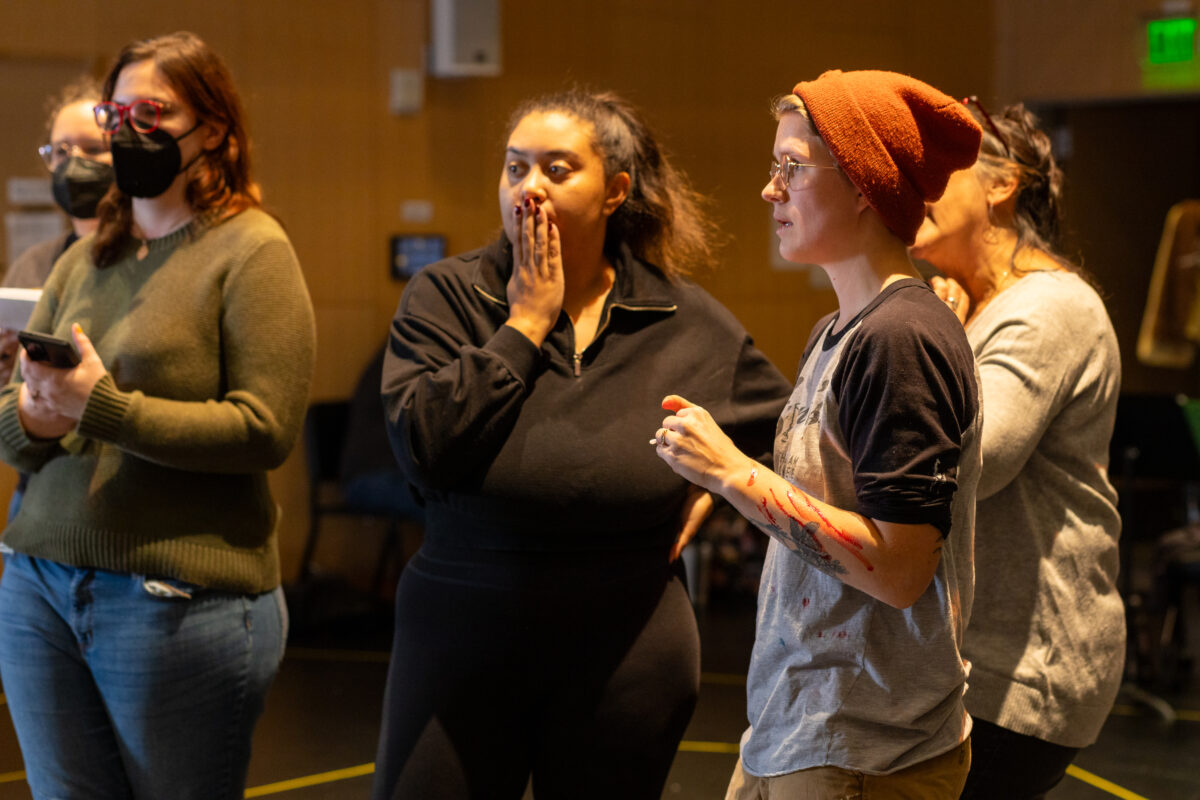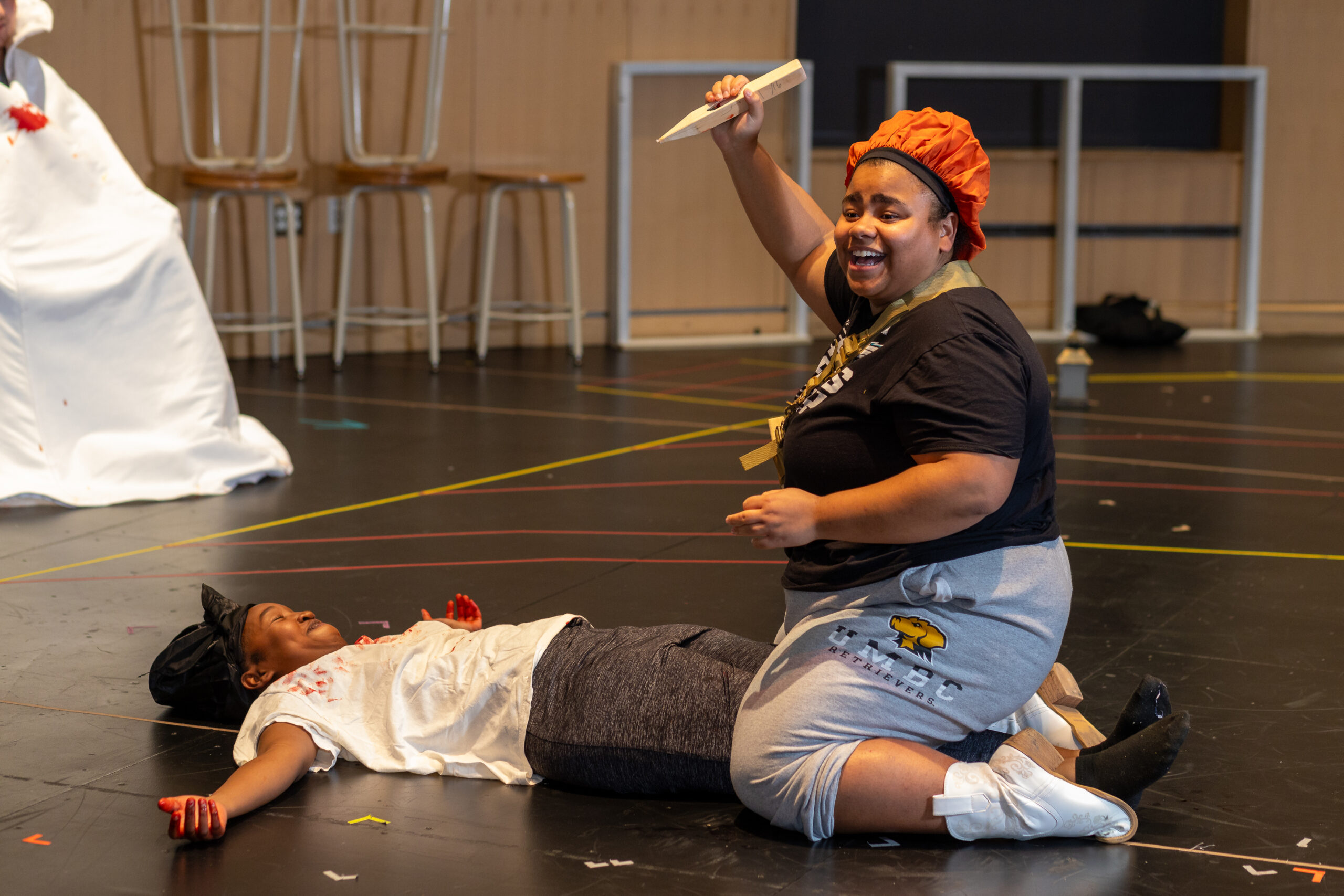Van Helsing straddles the vampire, brandishing her cross and wooden stake. The undead—mouth and shirt stained with blood—had just confessed to a brutal kill when the vampire slayer brings down her stake. A half second delayed, a comically small amount of blood spurts from the wooden prop. Van Helsing, played by Franchesca Parker ’25, acting, and the rest of the group in the theatre rehearsal space titter at the anticlimactic moment. Tessara Morgan Farley, production stage manager, and Sierra Young ’23, the fighting and intimacy director, immediately jump in to triage a better death for the vampire, Lucy (played by Liza Mupende ’25, action and information systems technology).
It’s stage blood rehearsal day for UMBC’s fall production of Dracula: a Feminist Revenge Fantasy, Really by Kate Hamill, directed by Kathryn Chase Bryer (running November 2 – 12). Snags like this are the reason the crew is spending four hours on a Monday evening trying out blood capsules, strawberries (aka, mini bags of stage blood), sponges loaded with blood dye, and grits mixed with edible stage blood for various effects on stage.
What does it take to pull off a veritable bloodbath on stage for six performances? That’s what this crew of staff and students aim to find out.
Left to right: Baggies of edible stage blood called strawberries; a crew member cleans the rehearsal floor during practice; various types of blood and props waiting for trial and error. (Kiirstn Pagan ’11/UMBC)
Tools of the Trade
1. 2,000 ounces of stage blood, some homemade, some bought
2. LOTS of baby wipes
3. Several mops and buckets
4. A taste for corn syrup
Step 1—Finding the right vein
For Morgan Farley and Emerson Balthis ’24, theatre design and production, assistant scenic designer and newly-christened stage blood mixologist, finding the perfect combination of purchased and homemade stage blood was a multi-month project. Several of the pressing questions at hand: Some of the blood needed to be edible—could they make it taste at least OK? Was anyone allergic to the substance? Most importantly, could it be washed out of the costumes every night? Oh yeah, and how to stay on budget?

“It’s going to be a bloodbath on stage,” says Morgan Farley, “but also not being too excessive to the point where it becomes funny. We’re trying to go more in the vein of reality versus comical, which also influenced our choice of color for blood. Of course, we were looking for washability, but we were also looking at the color and the viscosity.”
In order to stretch the budget, Morgan Farley and Balthis found ways to water down what they bought and manufacture the rest— simmering vats of chocolate syrup, corn syrup, food coloring, and various thickening agents dissolving into a viscous, sugary brew.
Step 2—Out damned spot

Moods are high, hands are stained red, and it’s obvious the student actors are having a blast (and most likely, a sugar high, based on the recipe). Standing in a six-foot-long pristine white cape—except for a few new blood smears—with a curved collar another foot high, Cece Smith ’24, acting, who plays Dracula, is nearly giggling with glee.
“I’m having so much fun,” says Smith. “I honestly don’t see a downside to the blood, even when it gets all sticky and nasty—it makes me feel pretty badass.”
Enter the people responsible for wardrobe and laundry: Margaret Caster, assistant costume shop manager and wardrobe supervisor, and Jennie Hardman ’23, theatre studies and environmental studies, wardrobe head for the show. While they could potentially see downsides galore, the duo is taking their tasks in stride.
“It was a little bit of ‘oh no,’ if I’m going to be honest,” says Hardman, who has worked on many UMBC shows in her time as a student, but this is her first as wardrobe head. “When you read the script, there is so much blood. So you think, ‘We’re going to do this with real red liquid. On white colored clothing. Oh boy, that’s going to be my problem, isn’t it!’”
“I’ve done blood shows before, so it’s not my first blood rodeo,” says Caster, “but I like to think of it like ‘How do you wrangle the blood?’ Because as you can see, it spreads everywhere. So my side is to think, ‘How can we contain it?’”
Their answer? Overnight soaks in Oxiclean and Shout spritzes for the tougher stains.
Step 3—Making the magic happen
In her role as an intimacy and fight director, Sierra Young has done vomit, has done other bodily fluids, has done blood—but never this much blood. Her job, as she puts it, “is to choreograph all of those big heightened moments so that they’re specific, repeatable, and narratively dynamic. And then give the actors tools to create a culture that is consent forward and trauma informed so they can feel secure in that space to create.”
In a feminist revenge fantasy based on Bram Stoker’s Dracula, unsurprisingly, there are a lot of opportunities for staging violence and intimacy, often at the same time. The added layer of Young’s already substantial task is designing the choreography so that the blood effects can be effectively masked.

This means actors are subtly handing off blood capsules to each other, picking them up from behind stage props, or accessing them from hidden pockets. “In terms of choreography, how do I hide these things, because stage combat is the illusion of danger. It’s a lot of magic tricks and misdirection.”
“We’re doing this show on purpose,” adds Eve Muson, associate professor of theatre and chair of the Theatre Department at UMBC. “These extravagant elements are for teaching purposes.”
Step 4—In pursuit of a good death
Back to rehearsal and the problem of Van Helsing’s stake and the paltry amount of blood it produced. The actors, Parker and Mupende, are game to try any workarounds suggested by Morgan Farley and Young. They finally land on a blood strawberry that Parker-as-Van Helsing will place upstage of Mupende-as-the-vampire-Lucy.
While writhing after Van Helsing’s stab, Lucy puts the baggy of blood in her mouth and chomps down. She bends over to gasp her last undead breath, spewing the leftover plastic at the same time, looking as much like viscera as imaginable. The entire rehearsal space erupts in applause at the successful, bloody death.

